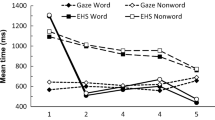Abstract
Research on the processing of homophonic homographs during reading is reviewed. The primary dependent variable considered was fixation time on target homographs. Both the characteristics of the homograph (whether there are two equally likely meanings or one dominant meaning) and the characteristics of the preceding context (whether it is neutral or contains disambiguating information) were varied. When the preceding context was neutral, readers fixated longer on balanced homographs (homographs having two equally likely meanings) than on control words matched on frequency and length, but didn't look any longer at biased homographs (homographs having a highly dominant meaning) than matched control words. However, when the preceding context disambiguated toward the subordinate meaning, readers fixated longer on a biased homograph than a matched control word (the subordinate bias effect). Attempts to eliminate the subordinate bias effect are described and the implications of our research for models of lexical ambiguity resolution are discussed.
Similar content being viewed by others
References
Balota, D. A., Pollatsek, A., & Rayner, K. (1985). The interaction of contextual constraints of parafoveal visual information.Cognitive Psychology, 17, 364–390.
Dopkins, S., Morris, R. K., & Rayner, K. (1992). Lexical ambiguity and eye fixations in reading: A test of competing models of lexical ambiguity resolution.Journal of Memory and Language, 31, 461–477.
Duffy, S. A., Morris, R. K., & Rayner, K. (1988). Lexical ambiguity and fixation times in reading.Journal of Memory and Language, 27, 429–446.
Ehrlich, S. F., & Rayner, K. (1981). Contextual effects on word perception and eye movements during reading.Journal of Verbal Learning and Verbal Behavior, 20, 641–655.
Francis, W., & Kucera, H. (1982).Word-frequency counts of modern English. Providence, RI: Brown University Press.
Inhoff, A. W., & Rayner, K. (1986). Parafoveal word processing during eye fixations in reading: Effects of word frequency.Perception & Psychophysics, 40, 431–439.
Kintsch, W., & Mross, E. F. (1985). Context effects in word identification.Journal of Memory and Language 24, 336–349.
Kucera, H., & Francis, W. (1967).Computational analysis of present-day American English. Providence, RI: Brown University Press.
Morrison, R. E., & Rayner, K. (1981). Saccarde size in reading depends upon character spaces and not visual angle.Perception & Psychophysics, 30, 395–396.
Onifer, W., & Swinney, D. A. (1981). Accessing lexical ambiguities during sentence comprehension: Effects of frequency, meaning and contextual bias.Memory and Cognition, 9, 225–236.
Paul, S. T., Kellas, G., Martin, M., & Clark, M. B. (1992). Influence of contextual features on the activation of ambiguous word meanings.Journal of Experimental Psychology: Learning, Memory, and Cognition, 18, 703–717.
Rayner, K., & Duffy, S. A. (1986). Lexical complexity and fixation times in reading: Effects of word frequency, verb complexity, and lexical ambiguity.Memory & Cognition, 14, 191–201.
Rayner, K., & Frazier, L. (1989). Selection mechanisms in reading lexically ambiguous words.Journal of Experimental Psychology: Learning, Memory, and Cognition, 15, 779–790.
Rayner, K., Pacht, J. M., & Duffy, S. A. (1993).Effects of prior encounter and discourse bias on the processing of lexically ambiguous words: Evidence from eye movements. Paper submitted for publication.
Rayner, K., & Pollatsek, A. (1987). Eye movements in reading: A tutorial review. In M. Coltheart (Ed.),Attention and performance XII: The psychology of reading (pp. 327–362). London: Erlbaum.
Rayner, K., Sereno, S. C., Morris, R. K., Schmauder, A. R., & Clifton, C. (1989). Eye movements and on-line language comprehension processes.Language and Cognitive Processes, 4, SI, 21–49.
Seidenberg, M. S., Tanenhaus, M. K., Leiman, J. M., & Bienkowski, M. (1982). Automatic access of the meanings of ambiguous words in context: Some limitations of knowledge-based processing.Cognitive Psychology, 14, 489–537.
Sereno, S. C., Pacht, J. M., & Rayner, K. (1992). The effect of meaning frequency on processing lexically ambiguous words: Evidence from eye fixations.Psychological Science, 3, 296–300.
Sereno, S. C., & Rayner, K. (1992). Fast priming during eye fixations in reading.Journal of Experimental Psychology: Human Perception and Performance, 18, 173–184.
Swinney, D. A. (1979). Lexical access during sentence comprehension.Journal of Verbal Learning and Verbal Behavior, 18, 645–659.
Swinney, D. A., Onifer, W., Prather, P., & Hirshkowitz, M. (1979). Semantic facilitation across sensory modalities in the processing of individual words and sentences.Memory & Cognition, 7, 159–165.
Tabossi, P. (1991). Understanding words in context. In G. B. Simpson (Ed.),Understanding word and sentence (pp 1–22). Amsterdam: North Holland Press.
Tanenhaus, M. K., Leiman, J. M., & Seidenberg, M. S. (1979). Evidence for multiple stages in the processing of ambiguous words in syntactic contexts.Journal of Verbal Learning and Verbal Behavior, 18, 427–440.
Author information
Authors and Affiliations
Additional information
Preparation of this paper was supported by grant DBS-9121375 from the National Science Foundation. We wish to thank our colleagues Sara Sereno and Chuck Clifton for their helpful comments on earlier drafts of this paper.
Rights and permissions
About this article
Cite this article
Pacht, J.M., Rayner, K. The processing of homophonic homographs during reading: Evidence from eye movement studies. J Psycholinguist Res 22, 251–271 (1993). https://doi.org/10.1007/BF01067833
Issue Date:
DOI: https://doi.org/10.1007/BF01067833




